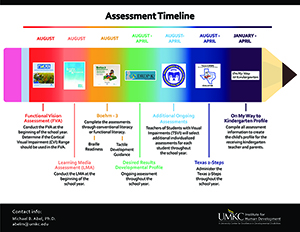"On My Way to Kindergarten:" Assessing Visually Impaired Children's Kindergarten Readiness
May 6, 2022

|
The transition to kindergarten is a challenge for many children with visual impairment, their families, and teachers. Visual impairment includes those who have trouble seeing, even with eyeglass use or contact lenses, or people who are blind.
“Children with visual impairment require a thoughtful and cohesive program that includes the core curriculum typically utilized in general education and a specialized curriculum unique to children with visual impairments,” said Lisa Lind, chief program officer at The Children’s Center for the Visually Impaired (CCVI).
But comprehensive assessments for overall development, knowledge, or skills appropriate for children with visual impairment are nonexistent, which makes it difficult to meet these children’s educational needs. Kindergarten readiness assessments used for other children are not appropriate, as they require visual acuity.
“Another problem is that a general kindergarten teacher may not know they are going to have a child with visual impairment in their classroom until right before school begins,” said Mike Abel, associate director of research and evaluation at the UMKC Institute for Human Development. “They are given the child’s Individualized Education Program (IEP) with a bunch of jargon in it, and that is all. They don’t know how to accommodate a child with vision impairment in their classroom.”
Researchers from the UMKC Institute for Human Development partnered with the leaders at the Children’s Center for the Visually Impaired, and other experts in education. Together they explored the need for better measures of kindergarten readiness for children with visual impairment, and the development of specialized decision-making tools. The purpose of the project was to provide solutions to guide teachers of the visually impaired, as well as kindergarten teachers, IEP teams, and personnel at receiving schools.
“The project is critical in the field of visual impairment because it is something we have not looked at closely for some time,” Cathy Smyth, director of research at Anchor Center for Blind Children in Denver, Colorado, said. “The guidance we used in the past is no longer relevant, we need to look for promising practices to do this better.”
The project team developed a decision tree that educational professionals can use to select assessments for children with visual impairment. The decision tree’s first step is to administer a battery of assessments to identify if a child is a visual or a tactual learner. The second step is to administer further assessments based on the identified learning style.
Next, the project team developed a two-page, “On My Way to Kindergarten” profile that summarized the results of the assessments and provided a snapshot of each child for kindergarten teachers and parents. The profiles were written in first-person, as if each child were explaining what to expect from them in kindergarten, and what accommodations they might need in the classroom.
“The project is valuable to the children served and their families because it provides a blueprint for important skills to be taught, communication to the family, and to the receiving schools.” Lind said.
Results of the research study were presented at the American Educational Research Association Annual Meeting in April 2022.







